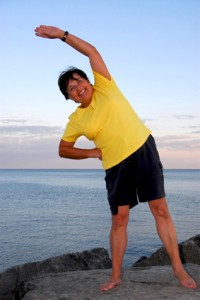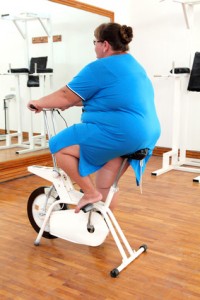Dr. David Eisenberg, an associate professor at the Harvard Medical School and the Harvard School of Public Health in Boston, Massachusetts, is the founder and chief officiant of an annual event called “Healthy Kitchens/Healthy Lives.” This is an “interfaith marriage,” as he calls it, that brings together physicians, public health researchers and distinguished chefs. The program seeks to tear down the wall between “healthy” and “crave-able” cuisine.
Health care providers are on the front lines of America’s diabetes and obesity crises, but many of them have little knowledge of nutrition, let alone cooking.
To Dr. Eisenberg, son of a Brooklyn baker, “flavor is a health issue.” He thinks that it’s vitally important that people know how to cook healthy food that is enjoyable to eat. And he’s striking a chord; the “Healthy Kitchens/Healthy Lives” event is now in its eighth year, and typically sells out, according to this article in the New York Times. It is an example of a major shift in attitude among a young generation of medical professionals who grew up with farmers’ markets. As a physician participating in the event says, “I want to help my patients not need my services… I’d love to be put out of work.”
For Dr. Eisenberg, 56, a passionate cook who spent weekends as a child filling cream puffs and sprinkling cinnamon and nuts on rugelach in his father’s bakery, deprivation in the form of low-fat diets and bland overcooked vegetables is an enemy of doctors and patients. “For years we’ve told people ‘Don’t eat that’ or ‘Here’s your problem,’” he said of the physicians’ party line. “Sometimes,” he added of his own thrice-yearly yearning for steak, “you have to feed your inner jerk.”
His commitment to healthy food began when his father, a cake artist who “always smelled like a cross between a cinnamon stick and a whiff of Old Spice,” died of a heart attack when Dr. Eisenberg was 10. An expert on integrative medicine, Dr. Eisenberg was one of the first United States medical exchange students to the People’s Republic of China. He started “Healthy Kitchens/Healthy Lives” in partnership with the Culinary Institute and the Harvard School of Public Health, based on the radical notion that if doctors could learn to channel their inner Julia Child (sans butter), they could serve as role models and cheerleaders for their patients.
It’s not about ego. Over the years, research has shown that doctors who practice healthful behaviors like exercising, using sunscreen and not smoking have a greater likelihood of advising patients to do the same. A study last month in the journal Obesity reported that overweight doctors may be less prone than other physicians to discuss diet and exercise with their patients. “We’re all human,” said Dr. Matt Everett, a now-gangly 55-year-old physician from Marysville, Ohio, who was inspired to lose weight after seeing patients in their 40s and 50s having strokes and heart attacks. “We all struggle with the same things.”
For doctors like Martin Abrahamson, the chief medical officer for the Joslin Diabetes Center in Boston, there were revelations within Greystone’s cool, monasterylike stone walls, where chefs in white glide up and down staircases with nary a glance at the school’s historic corkscrew collection. “I’ve never cooked in my life,” he said, wearing a pinstripe suit beneath his apron, his hands drenched in marinade.
Dr. Abrahamson and his cronies listened raptly as the chef Tucker Bunch talked about “the little worm that unfurls” in overcooked quinoa (he advocates toasting it). “Doctors treat salt like an exacerbator of disease,” Mr. Bunch observed somewhat wryly. “So they under-season food with religious fervor.”
Nevertheless, they soaked up the dazzling feats of culinary derring-do, especially when the chef Patrick Clark sliced an onion in 10 seconds that fell into Sydney Opera House-like curves on the cutting board.
The collaboration between the Culinary Institute and Harvard epidemiologists and nutritionists goes back to 2002, when Dr. Willett, chairman of the institute’s scientific advisory board, began researching the health benefits of the Mediterranean diet. The team is now working with chefs from mega-chains like Applebee’s, Starbucks and Subway, to encourage them to reduce sodium and add more whole grains, nuts, legumes and healthier oils to their menus.
Dr. Eisenberg would like to see teaching kitchens in the places that need them most: medical schools, hospitals, universities, public schools and military bases. “What if teaching kitchens were as prevalent as computer labs in schools?” he asked. (He is working on a prototype.) Nutritionists often don’t know how to cook, Dr. Eisenberg pointed out, “which is a little bit like psychiatrists who are all screwed up.”
Yet after three days of thinking deep thoughts, all the while gorging on aromatic wheat-berry salads and peanut limeade (sounds revolting, tastes great), there was a palpable sense of a wellness tide turning.
For instance, Dr. John Principe of Palos Heights, a Chicago suburb, said that he seriously thought about quitting medicine, fed up with “a pill for every ill.” Fantasizing about a second career as a chef, he attended “Healthy Kitchens” five years ago and realized that he might be able to combine the two.
He now holds a culinary boot camp in the 2,400-square-foot kitchen and lecture room he built below his medical office, where he teaches people how to whip up cauliflower crust pizza and other dishes. (The sessions qualify for insurance under the group medical appointment model.) “Instead of being in the downtrodden mode, it’s given me a zest for life,” he said.
At the Baylor College of Medicine, Jasdeep Mangat, a 24-year-old medical student, was a founder of Choosing Healthy, Eating Fresh (CHEF), enlisting a chef from a local bistro to teach classes for 20 students using five portable gas burners in the student lounge. “We need to walk the talk,” he said.
And seven years ago, Dr. Daniela Connolly, now 40, and her husband, Patrick, bought a farm in Chester, N.H., to feed their five children healthy and reliable food.
She often runs into her patients while selling eggs at the farmers’ market and sometimes when they unknowingly show up at the house to pick up their Field to Fork Farm C.S.A. boxes. They are invariably surprised by how dirty she is.
After three days of “Healthy Kitchens,” she is now convinced she needs to teach her patients healthy cooking. “In a perfect world, I would have my patients meet me at the farm,” she said. “That would make me a really happy doctor.”





